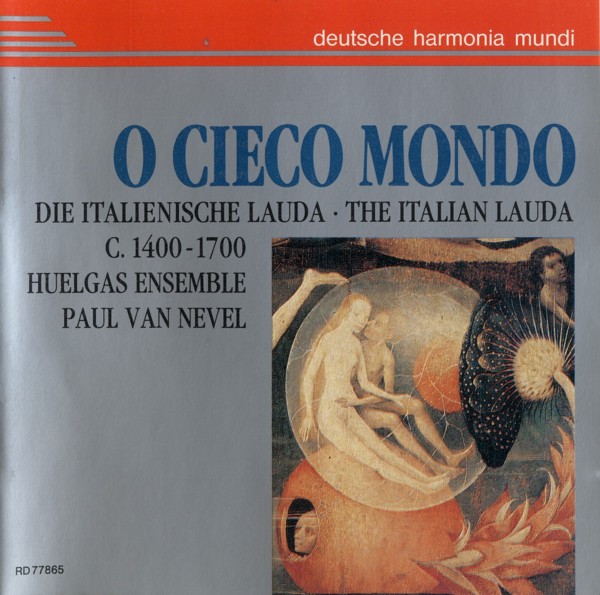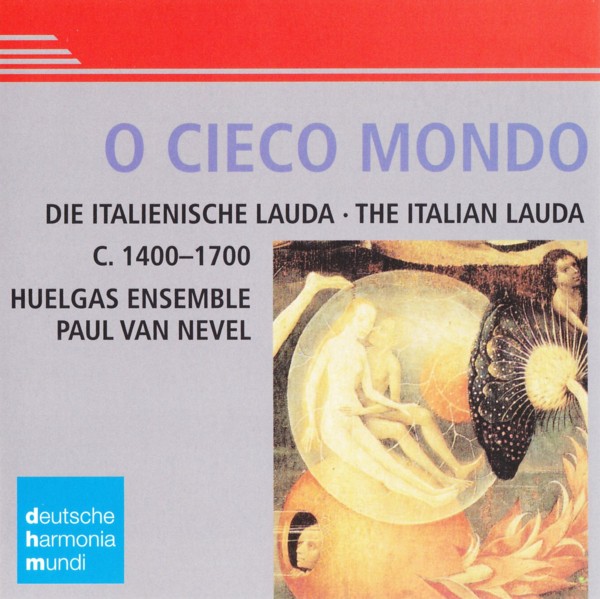
medieval.org
Deutsche Harmonia Mundi (BMG) RD 77865
1989

medieval.org
Deutsche Harmonia Mundi (BMG) RD 77865
1989
1. Volgi gli ochi, o madre pia [5:27]
Laude Libro Secondo, folio 27 verso, Petrucci, Venezia 1507
Music: Alexander Demophon VENETUS
2. Ave corpus vere natum [2:37]
Bologna, Ms. Biblioteca Universitaria, ms. 2116, pagina 60-61
Music: Anonymous
3. Dolor pianto [5:08]
Fra Serafino Razzi, Libro primo delle Laudi Spirituali, Venezia 1563
Music: Anonymous
4. Ave maris stella [2:53]
Faenza, Biblioteca Comunale, Codex 117, folio 96 verso, 97 recto
(Original: two-part, in this version countertenor is added)
Music: Anonymous
5. Io ti lascio [5:47]
Padova, Biblioteca Universitaria, Ms. 684, folio 1 verso
Music: Francesco LANDINI (1325-1397), cf. of Ballata "Gram piant'agli ochi"
6. Signor per la tua fe [4:03]
Fra Serafino Razzi, Libro primo delle Laudi Spirituali, Venezia 1563
Music: Anonymous
7. Helas me celes [3:20]
Escorial, Real Monasterio de San Lorenzo del Escorial. Biblioteca y Archivo de Música, Ms. IV.a.24
Music: Anonymous
8. Chi c'insegna ov'è Gesù? - Nell' arrivare alla Chiesa [7:19]
Laude e Antifono da cantarsi nel pellegrinaggio alla S. Casa di Loreto l'anno 1729, Firenze 1729
Music: Anonymous
9. O cieco mondo [5:48]
Firenze, Biblioteca Nazionale Centrale, Codice Musicale Panciatichi 26, folio 65 recto
Instrumental variation between both verses from Codex Faenza, Biblioteca Comunale, Ms 117
Music: Jacopo da BOLOGNA (c. 1310-c.1351)
10. Chi vol seguir la guerra [2:33]
Il primo libro delle Laudi Spiritali a tre voci, Roma 1585
Music: Anonymous
11. Che bella vit'ha'l mond'un villanello [3:13]
Fra Serafino Razzi, Libro primo delle Laudi Spirituali, Venezia 1563
Music: Anonymous
12. Sequenza de morti [3:26]
Tutti li otto toni a falso bordone di Vicenzo Ruffo, Vineggia 1578
Music: Falso-Bordone, versión de Vicennzo RUFFO (c. 1510-1587)
13. Plus sui en bone compagnie [4:30]
Text: Biblioteca Marciana di Venezia, Ms. Ital. IX 145 folio 39 verso, 41 recto
Music: Anonymous,
Escorial, Real Monasterio de San Lorenzo del Escorial, Biblioteca y
Archivo de Música,
Ms. IV.a.24, c. 1460, folio 79 verso, 80 recto
14. Alma che scarca dal corporeo velo [4:49]
Fra Serafino Razzi, Libro primo delle Laudi Spirituali, Venezia 1563
Music: Anonymous

HUELGAS ENSEMBLE
Paul van Nevel
Katalijne van Laethem, Sopran
John Dudley, Tenor
Josep Cabre, Bariton
Willem Bremer, Blockflöte, Zink, Dulcian
René van Laeken, Dulcian, Fiedel
Schola: Chris Nieuwenhuysen, Nele Minten, Anne Mertens, Rika Joris, Godfried van de Vyvere
The Huelgas Ensemble
The Huelgas Ensemble was founded by Paul van Nevel in 1971. The ensemble's name was borrowed from the Spanish abbey of Las Huelgas, near Burgos. It is in this abbey's library that one of the most important manuscripts of early music is preserved. Originally the Huelgas Ensemble constituted four musicians. In 1972 the Huelgas Ensemble was a prize winner in the international competition for early music at the Festival of Flanders at Bruges. The Huelgas Ensemble has given concerts throughout almost the whole of Europe and at all the important festivals.
The group has also recorded quite a number of records and has worked with the most important European radio and television stations. In 1981 the ensemble carried off first prize in the Concours Radiophonique Européen for early music at Innsbruck with a programme dedicated to Johannes Ciconia.
Paul van Nevel
Following musical studies in the Netherlands and Germany Paul van Nevel specialised in the music of the Middle Ages and Renaissance. The choice was certainly influenced by Prof. Hans Martin Linde whose assistant Paul van Nevei had been at the Schola Cantorum Basiliensis from 1969 to 1971. At Basle Paul van Nevei devoted himself to the study of musical notation and the origins of polyphonic music up to 1580. At present Paul van Nevei teaches musical notation and interpretation of the music of the Middle Ages and Renaissance at the Centre de Musique Ancienne at Geneva and at the Conservatoire Sweelinck at Amsterdam. He has given concerts in the majority of European countries, as an instrumentalist as well as as conductor (among others with the group "Nederlands Kamerkoor"). In his capacity as an author Paul van Nevei has published several studies and monographs and he has had articles on early music published in specialised journals.
Ⓟ1989 by BMG Music
©1989 by BMG Music
Producer &Recording supervision: Wolf Erichson
Engineering: Tritonus, Stuttgart
Recording & Editing: Andreas Neubronner
Recorded: The Chapel of the Irish College, Leuven, 18.-20. April 1988
Text: Paul van Nevel
Translation: Lynda Enders
Design: B &M Wiesinger
Front cover illustration: Hieronymus Bosch (c. 1450 — 1516),
Excerpt from the middle part of the Triptychon, Museo del Prado, Madrid
Photo: Archiv für Kunst und Geschichte, Berlin
Editing: Rudolf Moratscheck, Bruno Ochsner
All rights reserved

The Italian Lauda
"Lauda"
literature contains music for one or several parts with sacred texts
written in the vernacular. The "lauda" has been sung at meetings of
lauda singers, the "Laudesi", the "Disciplinati Gesù Cristo", since the
13th century. These fraternities were founded in Perugia in 1258 by
Ranieri Fasani and consisted of simple craftsmen. In their social
structure the "Laudesi" resembled the German "Gilden". They were very
popular in 15th and 16th century Italy. At the beginning of the 15th
century there were more than 40 "Laudesi" in Perugia alone. At the end
of the 16th century there were 137 fraternities in Florence. In the 17th
and 18th centuries the "Laudesi" tradition was continued in the
"Congregatione dello Oratorio" which Philippo Neri (1515-1595) had
founded during the course of the counter-reformation as a secular order.
The
heart of the Laudesi meetings were the word and the music. The texts of
the songs, couched in a simple, vivid, strong language, are about
death, the Last Judgement, the fleeting earthly existence. Besides songs
with texts from the New Testament, there were also hymns to Mary and
procession hymns. The music of the lauda is moving in its simplicity and
clear structural lines. The style is syllabic and homophone, above all
in the repertoires of the 15th and 16th century lauda. In contrast the
14th century lauda was composed in the trecento style with a rich,
melismatic melody which emphasizes the clearness.
The Laudesi
also used the so-called "travestimento spirituale" (religious disguise).
They set the lauda texts to popular songs. At the first lauda meetings
(between 1480 and 1512) no music was noted down. Each poem bears a
reference to a familiar melody "Cantarsi come..." ("to be sung as...").
Our recording contains two such "travestimenti spirituali". Vergene Bella is a French chanson for three parts which is performed in the original version Plus sui en bone compagnie. The second example of a "travestimento spirituale" is the lauda Io ti lascio, which is sung to the music of the ballad "Gram Pianto" by Francesco Landini (1325-1397).
The majority of the laudas recorded come from 16th century collections. Volgi gli occhi is an example of the simple, intoxicating style of these homophone compositions. Dolor pianto
deals with the fleetingness of the earthly existence (Vanitas) and with
the hereafter. This music was sung at the time of Savonarolas on the
"Carro della Morte" during the Shrovetide festivity. Alma the scarca
is a song of mourning from the famous 1531 collection by Fra Serafino
Razzi. It was sung at the burial of a member of a lauda fraternity in
Florence. Giorno Orrendo, a Sequenza de morte, alludes to the
"Dies Irae" and portrays the Last Judgement in falso-bordone style, the
famous Italian improvisation technique. Signor per la tua fe and Che bella vita are simple laudas for three parts which contrast with the scholarly Latin lauda Ave Corpus. The most recent example is the procession hymn Chi c'insegna ov'e Gesù
for one voice. Strangely enough, besides the simple text this lauda
already contains suggestions of an oratorical aria. Instrumentalists
were also always present at the Laudesi meetings. The illuminations of
the lauda manuscripts often represent musicians, the Joculatores Dei,
who were however disapproved of in the ecclesiastical circles of the
time.
The polyphonic lauda repertoire occupies a unique position
between the different Italian forms of polyphonic singing. It is
distinguished by a spontaneous and honest lyricism whose roots are to be
found in the colourful folk tradition.
Paul van Nevel
Translation: Lynda Enders